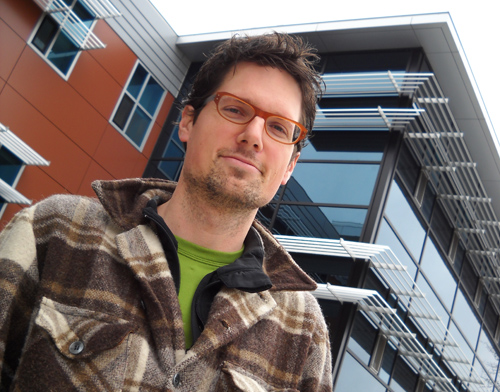
She coaxed grass to sprout all over a kitchen chair. He built Kentucky Perfect, a tabletop strip of lawn that automatically maintained itself. Apart from a shared interest in the ironic possibilities of turfgrass as a medium, artists Julie René de Cotret and Robert Hengeveld have something else in common: the position of artist-in-residence in U of G’s School of Environmental Sciences (SES).
Last month Hengeveld, a Toronto installation and multimedia artist, took over that post from René de Cotret, who had held it for the past two years.
A newcomer to Guelph, Hengeveld plans to start his new assignment by learning about people and projects on campus, particularly in the sciences. He says those explorations will help to inform his work, which invites viewers to examine the meeting place of reality and fiction.
He discussed his art during a joint lecture in early February with his predecessor. (They spoke in U of G’s newly renovated Alexander Hall, which houses SES as well as graduate studios for the School of Fine Art and Music.)
Kentucky Perfect was a modular installation featuring a 25-foot-long strip of grass grown on a tabletop. Viewers watched as electronics controlled irrigation, lighting and even mowing of what Hengeveld called a “Platonic form that only the Joneses could hope for.”
The work questioned our motives and abilities to control or even distort the built and natural world, he says. He also hoped to spark discussion about cultural norms and what happens when we strive to meet or even subvert them: the desire for status and respect, duty, guilt and pride.
Despite his best care, the lawn began to die. “I could not control that natural world. It was a hard pill to swallow, but it made the work stronger.”
Another project was a floating plastic replica of a shopping cart. Pitched into a lake, the cart was intended to provoke questions and challenge viewers. “Is it a shopping cart or not? It forces us to look and consider things we choose to ignore.”
“One of the roles of the artist is to challenge preconceptions and to help people see the world in a new way.” That’s not about burdening the work with messages or dogma, he stresses, but about encouraging viewers to ask their own questions.
Often the installation involves tweaking something just enough to make viewers puzzle out the strange in the familiar. The more real something appears, says Hengeveld, the more tension and conflict it can create.
Housed in a gallery and bristling with equipment, Kentucky Perfect was clearly a construct. Less obvious was a small tree that Hengeveld rigged up to rotate slowly outdoors. Some viewers encountered the tree more than once but failed to pick up on its revolution.
An installation is like any research project on campus, says Hengeveld. “It can be both respectful and challenging at the same time.”
As SES artist-in-residence for 2010-11, René de Cotret encountered her own challenges. Besides that grass-covered chair, she constructed works intended to be used by honeybees – including a pair of hollowed-out human arms made of beeswax – and manipulated a small tract near U of G’s agroforestry research plot to create a kind of trompe l’oeil effect on aerial photographs.
Originally from Montreal, she had studied there and in Nova Scotia and held artist-in-residence postings at other schools before meeting SES director Prof. Jonathan Newman. She says her appointment at Guelph helped her to work with scientists and different perspectives; besides completing her own works, she organized two campus lectures by visiting artists.
Appointed as SES artist-in-residence for 2012-13, Hengeveld studied at Georgian College, the University of Victoria and the Ontario College of Art and Design. His work has appeared in solo and group exhibitions in Canada and the United States.
Among his artistic inspirations, he lists New York sculptor Maurizio Cattelan, playwright and poet Bertolt Brecht, New York installation artist Ilya Kabakov and the Canadian BGL collective.
“I grew up where environmental sciences were part of daily conversation,” says Hengeveld. His dad was a climate expert with Environment Canada – “back in the days when global warming was a new thing. Ozone, CFCs, greenhouse gases were things I grew up hearing a lot. It frames how I see the world.”
Not that he’s necessarily an environmentalist or that he calls his practice strictly “environmental.” Still, he acknowledges that “it seems to creep into my work quite often.”
SES Prof. Claudia Wagner-Riddle points to parallels between the works of the scientist and the projects of the artist. Referring to her studies of the climate-change impacts of dairy farming, she says the experimenter’s need for control sometimes butts up against the vagaries of reality.
“We often go down blind alleys with no exit,” she says. “Research is all about discovery, and sometimes you make the wrong turn and things don’t work.”